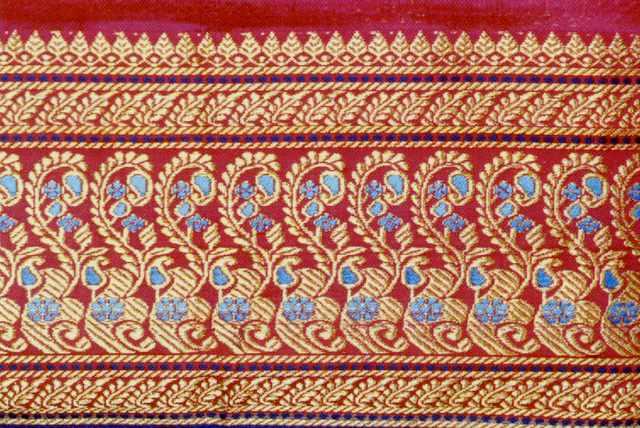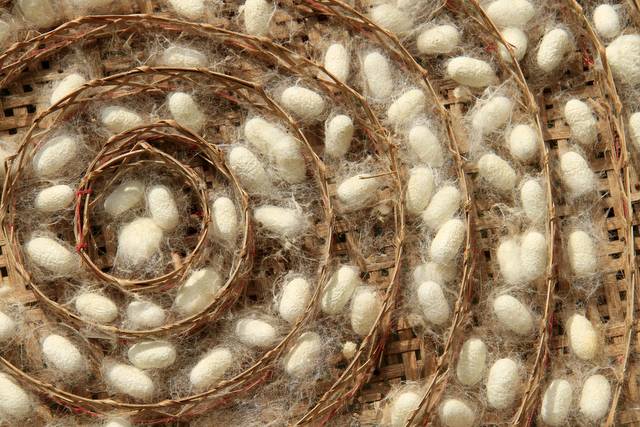Silks in India define the luxury quotient. Our auspicious occasions and celebrations are not complete without being wrapped in exquisite silks. The shimmering fabric adds an elegant aura to the wearer, giving us a regal look. Our weddings are no less than a silk-inspired fashion show with all possible types of silk being worn by the couple getting married and most of the guests. Other celebrations also have silks as their integral part. No wonder then, we are the biggest consumers of silk in the world along with being one of the largest producers of silk. More than 75% of this consumption is in the form of Silk Saris and the industry must thank the Indian women for their taste and appetite for silk.

Having said that, though silk has huge aspirational value it occupies a small share in the overall textile production. Types of Silk are also deeply integrated with the region it comes from. Each region has its own specialty, with its unique weaves, distinct patterns, and designs woven from silk yarn produced by a variety of silkworms. We typically identify silk with the place it comes from – Banarasi, Kanchipuram, Dharmavaram, Paithani, and so on. Well, those are the geographical indicators and most of our silk products have that tag, but we will talk about them some other day. Let us understand the different types of Silk in India and where they come from.
What is Silk?
On the face of it between the two natural textiles, cotton comes from the cotton plant and silk comes from silkworms. Let’s understand how silkworms give us this lustrous fabric.

Technically speaking, silk is made from the proteins secreted in the fluid state by a caterpillar, popularly known as ‘silkworm’. These silkworms feed on different plants and leaves and what they feed on is an important aspect of understanding different varieties of silk.
Coming from animal protein, silk is a natural insulator that helps keep the body warm in cold weather and cool in hot weather.
Lifecycle of a Silk Worm
The typical lifecycle of a silkworm goes from egg to caterpillar to pupa to moth. At the caterpillar stage, it weaves its cocoon. The filament thus generated is collected by we humans as the key input for our silks.

A female silk moth can lay up to 300-500 eggs, mostly during springtime, making it an annual activity. These eggs look like small dots. With warmth, the eggs hatch, and worms come out of them which are then reared on a bed of leaves. For about a month they eat a lot of leaves. Caterpillar or young Larvae reach maturity in few days.
At this stage, they start weaving their cocoon using their body protein and rigorously moving the body around. Woven for its own protection during its crucial life stage, a cocoon looks like a soft cotton ball. It is usually one single thread that they weave it with. After a lot of movement during the weaving of the cocoon, a motionless Pupa state follows. At this stage, they are either boiled to extract silk or allowed to grow into moths, which will again start the new cycle after mating.

Filament produced by silkworms is not really in a ready-to-use form. It needs to undergo several steps of processing before we can flaunt it. Cocoons are collected and boiled to remove the gum and separate the filament. A single silkworm produces a single thread that can measure up to a few hundred meters glued together with a natural gum called sericin.
Silk farming or Silkworm cultivation is called Sericulture. A common challenge for sericulture entrepreneurs is to keep their silkworms free of any infections or diseases that can impact their output.
Natural Color of Silk
The natural color of the silk filament depends on the color of the leaves consumed by the silkworm. Yes, the natural silk color is a result of what the worm eats before weaving its cocoon– a great case of ‘you are what you eat’. It usually varies in the colors of beige – varying from off-white to light brown and all possible shades in between. These natural-colored filaments are washed, cleaned, bleached, and then dyed in various colors as per the creative requirement of the weavers or the patron.

Traditionally, in the past, natural colors came primarily from plant sources including flowers, woods, seeds, berries, bark, roots, or even nuts. Indigo leaves gave us blue color, berries of Madder give us hues of red, yellow came from turmeric or marigold flowers or even cow urine, green came by mixing blue and yellow, saffron lends us shades of orange. Natural colors have a limited range but since they came from natural sources, they worked well for our skin and of course created no environmental hazards. With the advent of chemical colors, the range of shades available to us has increased manifold. The dying process has also become faster and easier as it is simpler to mix and create colors with chemicals.
Dyed threads are spun using traditional as well as modern methods in a process called reeling. This thread is now ready to be woven using different weaving techniques – a play of threads that creates magic.
Read More – Silk Saris at the intersection of Art, History, and Heritage
Different Types of Silk in India
The type of silk depends primarily on two factors – the species of the silkworm and the leaves that they feed on before they start weaving the cocoon. Broadly, there are two major categories – Mulberry and Non-Mulberry Silk.
Mulberry Silk
Mulberry silk is the most common form of silk comprising as much as 90% of global silk production. India is the second-largest producer of Mulberry silk. It comes from Bombyx mori worms that feed on mulberry leaves.
This silk comes with a natural sheen, softness, and smoothness that we so associate with silk drapes. Mulberry plants are cultivated to produce large quantities of leaves in a process technically called Moriculture. Roughly 500 grams of Mulberry leaves can feed one caterpillar for life. Do the rest of the maths and remember the silk they produce can last more than a hundred years.
Mulberry silk is light, smooth, strong, and comes with a natural sheen.
Vanya Silk – Wilder Types of Silk
Non-Mulberry silk in India comes in three prime varieties – Tussar, Muga, and Eri. Collectively they are also called Vanya Silk as they are a slightly wilder variety of silk. Vanya comes from the word ‘Vana’ meaning forest or the wild. The silkworms here feed on wild plants and the same is evident in the yarn they spin – it varies in color and texture, giving the final fabric an exotic look. This is a slightly raw variety of silk with not so uniform texture. Wild cocoons are collected from the forests by the tribes living closer to the forests, who then use them to hand weave silk.

Tussar silk
It comes from the Tussar belt of central India in the states of Jharkhand, Chhattisgarh, West Bengal, and Bihar. It occupies the biggest space in the Vanya silk category and is extremely popular among silk wearers. Moth Genus Antheraea feeds on wild plants of forests to produce this silk.
Eri Silk
Comes from Samia Ricini and Philosamia ricin variety of worms. Word Eri comes from Era which means Castor in local Assamese, where the silk primarily comes from. These worms feed on castor plant leaves and weave an open-ended cocoon. Eri cocoons are harvested only after they have hatched as the weaving of the cocoon is uneven and irregular, making it a natural Ahimsa silk. Eri, also known as Endi or Errandi silk is also known for its thermal properties that make it a great fabric to keep oneself warm.

Muga Silk
It is woven by the semi-domesticated multivoltine silkworm, Antheraea assamensis feeding on aromatic Som and Sualu leaves, primarily in Assam. This silk with a yellowish-green hue is the first choice for weaving Chadors and Mekhalas. It finds mention in many ancient scriptures of India like Ramayana and was patronized by the Ahom kings of the region.
For more details on Vanya Silk check out the Central Silk Board website.
Ahimsa Silk
Ahimsa silk is a variety of silk produced without the process of boiling the cocoons. It allows the larvae to become moths and break open the cocoon. As a result, the single long filament is broken into several small pieces. These must be spun together to form a long yarn, adding to the cost of the silk. It is still the same silk yarn, but it waits for the moth to come out of the cocoon.
Where are these types of Silk Produced in India?
More than 95% of silk production in the world happens in Asia, and the bulk of it happens in China and India. In the year 2020-21, India produced 33771 metric tonnes of silk yarn, most of which come from South and North East India. Karnataka, Andhra Pradesh, Jharkhand, and Assam are clear silk leaders of India.

For different types of silk production, India is divided into five silk zones constituting few states. They are Zone numbers:
- Karnataka, Andhra, Tamil Nadu, Maharashtra, Telangana, Kerala – 66% of silk production
- Uttar Pradesh, Chhattisgarh, MP, Rajasthan, Gujarat
- Jharkhand, West Bengal, Odisha, Bihar – About 10% of silk production
- Jammu and Kashmir, Uttarakhand, Himachal, Punjab, Haryana
- Assam, Meghalaya, Manipur, Nagaland, Tripura, Arunachal, Mizoram, Sikkim – 22% of silk production
Prominent Silk clusters are found in the same regions, each with their own weaves, patterns, and choice of colors like Tanchoi and Jamdani of Banaras, Paithanis of Deccan, or Balucharis of Bengal.
Silk Farming
Silk farming is a key cottage industry in India engaging more than seven million people in 59,000 villages across 25 states. About 60% of these are women. In a way, it is an industry that has lived through the industrialization wave and will be the harbinger of self-sustained local economies that India is moving towards. The cultural importance of silk ensures the regular demand by consumers. Our silk farmers, weavers, and fashion designers ensure that they steadily fulfill this demand with their hand-crafted and handwoven silks.

At this point our demand far exceeds our production, making us a net importer of silk. This also means there is a great opportunity for the new-age entrepreneurs to increase the supply of raw silk, innovate to create new products using silk, and integrate this ancient heritage of ours with the future lifestyle.















This post is 100 informative…I can realize it because I am from Assam and you know that Assam is famous for silk all over the world… thanks for sharing…
So many types of silks???? and
I had no idea that the colour of the silk thread depends on the colour of the leaf eaten by the worm???? Interesting kaki????????????????????
hey, thank you for sharing this informative blog you have explained very well each type of silk.
thanks for sharing wonderful blog
This blog on types of Silks is very good for readers
I wondered about what makes different types of silk. Now I understand why some silks are fine and some raw. Thank you.
This blog on types of Silks is very good for readers. We rarely come to know about simple facts like the thread woven by the silkworm is one long single thread.
Thank you so much for sharing this post on silks of India, I appreciate your work. It was a great informative post.
Thanks For Sharing Such a nice article…I appreciate your work.
Nice Post. Keep Sharing.
Great post keep sharing! Very nice information about silk, and stunning photos.
Really an amazing post on Silk Heritage. Learned a lot from here, waiting for the upcoming post.
Silk sarees are warm and enriching shades of colors and prints make an Indian woman look her traditional best for any occasion. Indian Silk Sarees are famous all over the world for their grandeur and the royal look that they exude. They are popular world wide and for every Indian woman, owning a silk saree is a pride.
Indian Silk Sarees are famous Indian it is warm and enriching shades of colors and prints.
Very nice really amazing post thank you for this.
NICE
Interesting blog post! I’m curious to know more about the different types of silk in India.
Thanks for sharing very useful information on silks in India to us its very important for everyone .
Much thanks. wanted to peruse effective blogging.Thanks for sharing this article . Was useful and informative.This helped me a ton.
This post completely changed my perspective on silks of India. Eye-opening and insightful!”